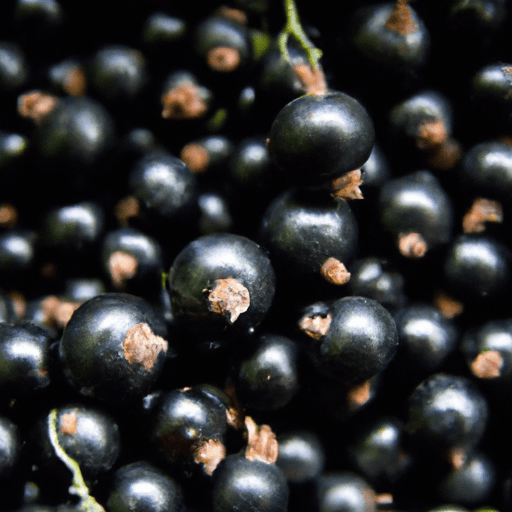All You Need to Know About Black Currants
Black currants, with their deep purple hue and tart flavor, have been appreciated for centuries. These small berries pack a punch, not only in taste but also in their extensive culinary applications. In this post, we’ll delve into the world of black currants, exploring their unique characteristics, nutritional benefits, and fascinating history.
Taste Profile and Culinary Uses
Black currants are known for their rich, tangy taste. They possess a delightful combination of sweetness and tartness, making them versatile for various culinary endeavors. Although their high acidity might be overpowering when eaten raw, cooking and sweetening can mellow their flavor.
In the kitchen, black currants lend themselves beautifully to both sweet and savory dishes. Their vibrant flavor pairs well with other fruits like apples, berries, and citrus fruits, making them an excellent addition to fruit salads, compotes, and jams. They can also be baked into tarts, pies, muffins, or used to flavor sorbets and ice creams.
Black currants are prized for their ability to enhance savory creations as well. Their tartness adds a refreshing twist to sauces and reductions for meats like duck and lamb. Additionally, they can be incorporated into chutneys and salsas, lending a burst of flavor to accompany grilled or roasted meats.
Nutritional Benefits
Beyond their culinary appeal, black currants are a nutritional powerhouse. Rich in vitamin C, black currants provide several times more of this essential nutrient than oranges. They are also an excellent source of dietary fiber, vitamin K, and antioxidants, which help combat inflammation and promote overall well-being.
Furthermore, black currants contain anthocyanins, pigments responsible for their vibrant color. These compounds have been linked to various health benefits, including improved cardiovascular health and reduced risk of chronic diseases.
Historical Significance and Fun Facts
Black currants have a long and storied history. Native to Europe and Asia, they’ve been cultivated for centuries and play a significant role in traditional European cuisine. However, their popularity waned in the United States and Canada due to a ban imposed in the early 1900s.
In the early 20th century, black currants were implicated in the spread of a tree disease called white pine blister rust, which threatened the timber industry. In response, a nationwide ban on black currant cultivation was enforced, lasting until recent decades. Nowadays, black currants are making a comeback, with renewed interest in their unique flavor and impressive nutritional composition.
Did you know that black currants are also used to produce the liqueur Crème de Cassis? Originating in France, this sweet and aromatic spirit adds a delightful twist to cocktails like the classic Kir or Kir Royale.
Conclusion
Black currants, with their bold flavor and versatile nature, are a treasure in the culinary world. From sweet treats to savory dishes, they bring a distinct tang and vibrant color to any recipe. Packed with vitamins, fiber, and antioxidants, they’re as nutritious as they are delightful. So, the next time you come across black currants, be sure to grab a handful and let your culinary creativity take flight!
Black Currant
Origin: Black currant (Ribes nigrum) is a small, tart, and juicy berry that belongs to the genus Ribes in the family Grossulariaceae. It is native to central and northern Europe and Siberia.
Common Uses: Black currants have a distinctive taste that can be described as both sweet and tangy. They are widely used in culinary applications, including making jams, jellies, juices, sorbets, and desserts such as pies and tarts. They can also be used in savory dishes like sauces, marinades, and dressings.
Nutritional Benefits: Black currants are highly nutritious and are packed with vitamins, minerals, and antioxidants. They are an excellent source of vitamin C, providing more than three times the amount found in oranges. They are also rich in vitamin K, potassium, manganese, and dietary fiber. Additionally, black currants contain several beneficial antioxidants, such as anthocyanins, which give them their dark color.
Unique Properties: Black currants are known for their intense and distinct flavor, which sets them apart from other berries. They have a deep purple-black color, which is attributed to the presence of pigment-rich anthocyanins. Black currant leaves have a strong aroma often used for flavoring teas, while the oil extracted from the seeds is sometimes used in skincare products due to its high content of gamma-linolenic acid.
Historical Significance: Black currants have a long history of cultivation and consumption in Europe, particularly in countries like Poland, Russia, and the United Kingdom. However, during the early 20th century, the cultivation of black currants declined in many countries due to concerns about their role in spreading a plant disease called white pine blister rust. In the United States, black currant cultivation was even banned for several decades. Fortunately, in recent years, the ban has been lifted in many states, and black currants are making a comeback.




Use the share button below if you liked it.
It makes me smile, when I see it.